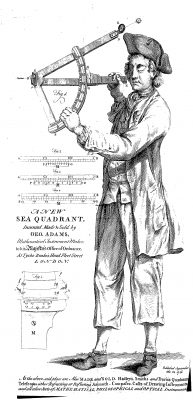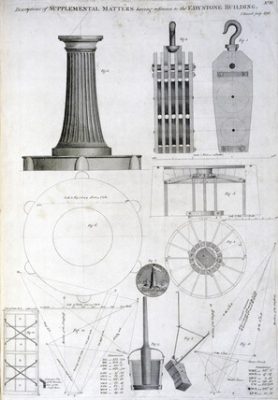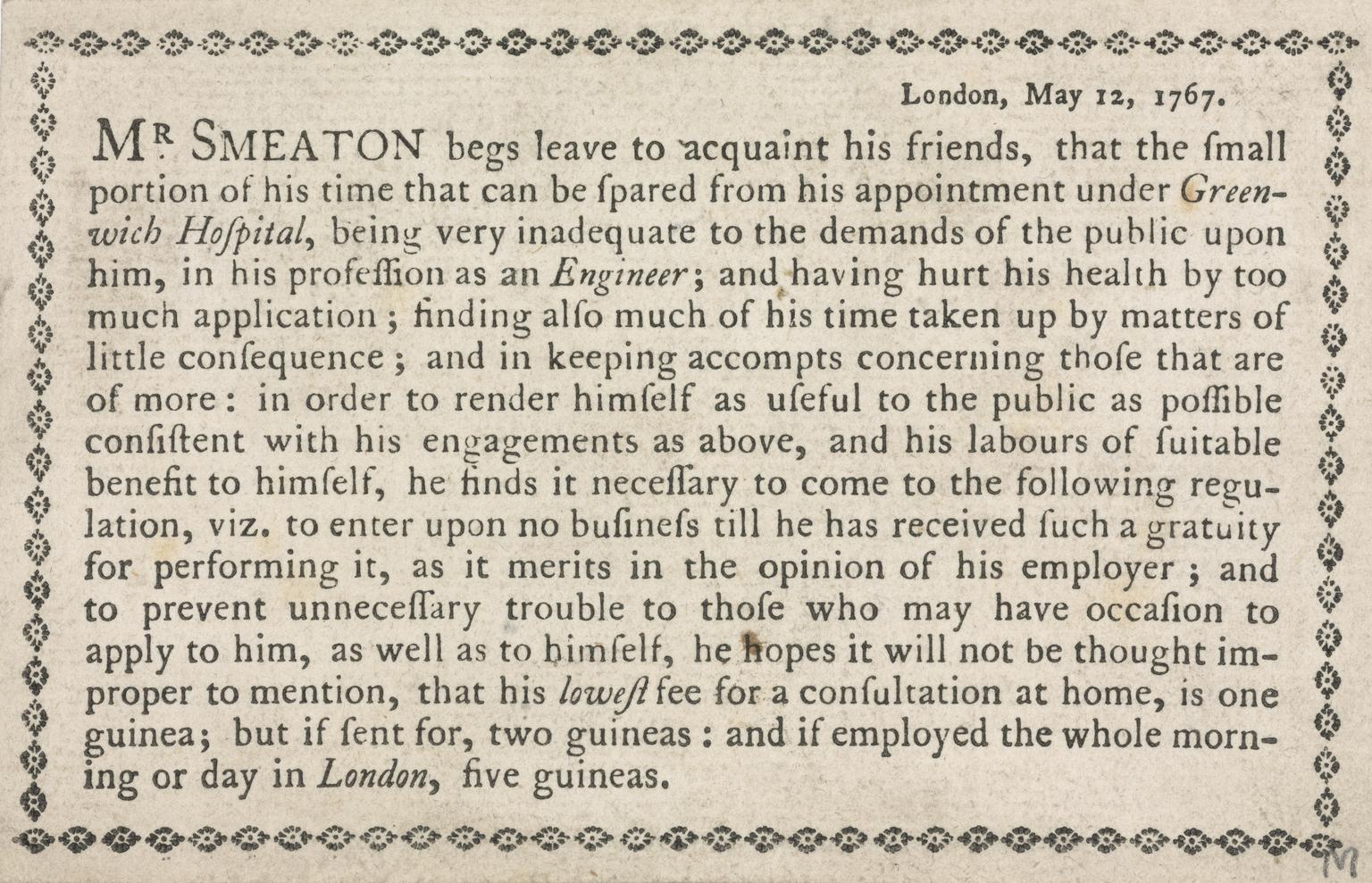Known as the “father of civil engineering”, John Smeaton (born in Yorkshire on 8 June 1724) is best known for his successful career as a professional civil engineer.
He had particular expertise in canals, bridges, harbours and other infrastructure projects, but it was the construction of the Eddystone lighthouse between 1755 and 1759 which truly cemented (if you excuse the pun) his reputation as a talented and ingenious civil engineer.
However, it was Smeaton’s earlier work in mathematical and scientific instrument-making, and especially his work on an improved ‘whirling speculum’, a pre-cursor to the modern gyroscope, which influenced his later work and successes.
Born in Austhorpe, Leeds on 8 June 1724, Smeaton’s background was not in the field of civil engineering but rather law. Smeaton’s father encouraged his son to follow him into the legal profession but Smeaton’s childhood interest in taking things apart and putting them back together instead came to the fore. Smeaton had the ability to quickly pick up the technical skills from those around him, to put them into practice and many times to improve them, an early biographer described him as “born an engineer.”
Nonetheless his father was concerned that his son wouldn’t be able to make a decent career from his tinkering and engineering ability and so sent him to London in 1742 to pursue an education and career in law.
Within a few years, Smeaton realised the legal profession was not for him and persuaded his father to support his career as a philosophical (scientific) instrument maker in London in the late 1740s (dates in historic accounts vary). In parallel with Smeaton’s instrument-making career, Smeaton became heavily involved with the Royal Society with one of his early papers, “An Account of some Experiments upon a Machine for measuring the Way of a Ship at Sea”, being submitted in 1753 and read in 1754, and around this time Smeaton’s talents were recognised by becoming a Fellow of the Royal Society (FRS).

Smeaton’s 1753/4 paper, unfortunately lacking illustrations, described the construction and operation of and experimentation with Smeaton’s ‘whirling speculum’ or horizontal top, essentially a prototype gyroscope or artificial horizon, produced through the use of a spinning top and used for marine navigation. Smeaton’s instrument was based on the earlier work of notable instrument maker George Adams and sea captain John Serson.
In about 1738, George Adams developed an early artificial horizon, which used a sextant to measure the angle between the sun and its image on a reflective mercury surface.
A decade later in 1748, Adams described his new sea-quadrant in “The Description and Use of a New Sea-Quadrant” which described two “curious” methods of creating an artificial horizon: one using a floating mercury mirror (as described above) and another by means of a whirling speculum.
Meanwhile in 1743, sea captain John Serson developed his own whirling speculum, a spinning top used as a level to locate the horizon in foggy conditions, and is generally credited as the inventor of the whirling speculum as his instrument was most likely constructed and publicised prior to George Adams’ 1748 publication mentioned above. However, Serson was unable to further develop his instrument as he was tragically lost at sea on the HMS Victory in 1744.
In 1751/2, a paper on Serson’s speculum “An account of an horizontal Top, invented by Mr Serson, by Mr James Short, FRS” was read before the Royal Society; a manuscript transcription of the paper can be found in the Science Museum archives.
James Short’s brief paper described further development of Serson’s speculum after Serson was lost at sea including Smeaton’s early contributions to understanding the underlying scientific principles and operation of this innovative scientific instrument.
Considered the inventor and constructor of the best air-pump (vacuum pump) Short had seen, Smeaton was asked to investigate whether air was the cause of the horizontality of the spinning Top, Smeaton’s experiments concluded that this was not the case.
In 1751, Smeaton developed and tested an improved whirling speculum for marine navigation, based on the research described in Short’s paper as well as Serson’s earlier work.
Smeaton initially hired a boat on the Serpentine river and later voyaged down to Thames “several leagues beyond the Nore” in a small sailing boat. Smeaton went on to further work in this area, collaborating with Dr Gowin Knight (1713-1772) in 1750 and 1751 with tests of Smeaton’s improved whirling speculum as well as a mariner’s compass designed and made by the pair.
Sea trails of the two instruments took place during a short cruise of HMS Fortune, a sloop of war, in the same year. The trials revealed that Smeaton’s whirling speculum was not useful and had severe problems with accuracy when used in heavy seas.
Meanwhile, Smeaton’s mariner’s compass, co-developed with Dr Knight, was of sufficient quality to become a Royal Navy standard issue and by 1751 Smeaton moved his instrument business from one part of Holborn, London to another, from Great Turnstile to a larger premises in Furnival Inn Court, and was employing three craftsmen.

Despite his ultimate lack of success with his whirling speculum, Smeaton’s experimental instrument marked a significant development in artificial horizons and can be considered a prototype of sorts for the modern gyroscope.
More generally, Smeaton’s experiments and papers before the Royal Society including his 1753/4 paper on his whirling speculum established his credentials as an instrument maker and researcher of renown and innovation.
By 1753, Smeaton had been made a prestigious Fellow of the Royal Society (FRS) in recognition of his innovations in marine and scientific instruments as well as his research into the mechanics of waterwheels and windmills.
Between 1753 and 1756, Smeaton further developed his career: acquiring in an interest in mechanics; taking on a series of small civil engineering projects mostly related to bridges and locks; and touring various “hydraulic features” in the Netherlands.
This combination of skills, research, and experience as well as his varied and innovative approach to instrument making and engineering led to Smeaton being recommended by the Royal Society to design and construct the new Eddystone lighthouse in 1756.
Smeaton’s Eddystone lighthouse, the third such lighthouse built over a period of 100 years at the dangerous location of Eddystone Rocks located fourteen miles from Plymouth in the English Channel. Smeaton’s ingeniously designed and constructed lighthouse built between 1755 and 1759 used ‘hydraulic lime’ concrete foundations which cured or dried underwater.
Smeaton’s model of these innovative foundations has been preserved at Leeds Museums and Galleries. Such was the strength of the foundations that when the subsequent fourth and current lighthouse, designed by James Douglass using Robert Stevenson’s developments of Smeaton’s techniques, was constructed on a new site in April 1879, the foundations of Smeaton’s earlier lighthouse, in place for 100 years, were too strong to be removed and so were left in situ.

Smeaton is credited with being the first person to use the term ‘civil engineer’ as a title and to differentiate himself from military engineers.
By 1767, such was Smeaton’s reputation and success, founded upon his many successful civil engineering projects including canals, bridges, harbours, and the Eddystone lighthouse, as well as his strong role in, and many papers before, the Royal Society that he was forced to issue a trade advertising card shown above outlining his limited availability and consulting costs.
The trade card informed Smeaton’s friends (read customers) that, due to his commitments as a professional civil engineer and his role as Receiver of the Smelt Mill at Langley on Tyne belonging to the Royal Hospital Greenwich, he was unable to be consulted by the public without payment.
Such was a measure of his success, reputation, and existing commitments that Smeaton found it necessary to charge for his consultations at the follow levels:
to enter upon no business till he has received such a gratuity for performing it … his lowest fee for a consultation at home, is one guinea; but if sent for, two guineas: and if employed the whole morning or day in London, five guineas.
Further information
Encyclopaedia Britannica: John Smeaton
Engineer Biography: John Smeaton
Smiles, Samuel. The Lives of the Engineers. Vol II: John Smeaton (1861). Available in digital form via Internet Archive.
